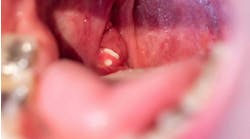by Lynne H. Slim, RDH, BSDH, MSDH
periocdent@mindspring.com
Early fall in New England is enchanting. My husband and I decided to visit good friends in New Hampshire, a state that was made for road trips and mountain climbing. I once climbed Mount Hale (one of the shorter, 4,000-foot elevations) and ended up with a bloodied ankle because I wasn’t wearing the right sneakers!
While up North, my dear friend Joan K. Fitzgerald, RDH, and I left our husbands behind for the day (drinking N.H. pumpkin ale at a local brewery in Portsmouth) while we attended a periodontal course in Massachusetts that was being taught by a Kentucky periodontist named Tim Donley.
Knowing nothing about Dr. Donley, I didn’t know what to expect, but I knew that I was in for a ride when I sipped my coffee and almost shot it across the room as I laughed at one of his opening comments.
Dr. Donley is a good friend of dental hygiene, and his brilliance is tied to his ability to make us laugh while challenging us to change our thinking about periodontitis. Hygienists are exceptionally good at teaching patients to disrupt biofilms (both cariogenic and periodontal). Over the years, dental hygiene education has emphasized instrumentation to remove new, mature, stained, and calcified supra- and subgingival biofilms. Growing evidence suggests that the host inflammatory response might dictate the composition of biofilms and the emergence of pathogens, and Dr. Donley discusses this new paradigm shift. (1, 2) He began his lecture by discussing risk assessment.
“Dental hygienists are not in the tooth cleaning business; they are in the risk management business.”
Not only does he talk the talk surrounding risk assessment; he gave us a sample risk assessment tool that he uses with his patients, and emphasized that it is reviewed every couple of years.
Here’s Donley at his best: “Now that periodontal inflammation is linked with chronic diseases of aging, you may one day find yourself at a live performance where one of the actors falls to the floor clutching his chest. Then, someone looks out to the audience and begs, ‘Is there a dental hygienist in the house?’”
This certainly provoked a roomful of laughter, but it’s important to recognize that aging per se is not necessarily correlated with periodontal disease etiology. As patients age, periodontal destruction increases gradually, but as Donley points out so humorously, disease progression in many susceptible adults is triggered by a patient’s inflammatory status. In other words, a patient’s risk factors accelerate inflammation, which create an ecosystem that favors periodontopathogens.
Here’s another Donley truism that almost knocked me off my chair: “Realizing that ultrasonic debridement can give the practitioner the best chance of achieving adequate subgingival debridement (and understanding that adequate debridement is essential to offset the risks associated with chronic periodontal inflammation), it is time for hygienists to ‘Say good night, Gracey.’”
He’s not saying that it’s time to get rid of all hand curettes (heaven forbid!), but his play on words suggests that the new emphasis on instrumentation should focus on recognizing the advantages of ultrasonic debridement over hand instrumentation. There are many excellent clinicians who use ultrasonics exclusively, and they have retired hand curettes to the bottom drawer.
Dr. Donley expressed his frustration with some dental hygiene programs. He feels strongly that the mastery of calculus removal as a main educational goal is unfortunate. The elimination of inappropriate oral inflammation, which may help reduce overall body inflammatory burden, is a worthwhile goal, and he’d like to see hygienists focus on what’s in the best interest of patients as opposed to clinical management of a particular “tooth.”
The chronic inflammatory nature of periodontal disease mandates, according to Donley, an ongoing commitment to inflammation suppression and patient education to that particular end.
References
- Stamm JW. Periodontal diseases and human health: new directions in periodontal medicine. Ann Periodontol 1998; 3:1-2.
- Ishikawa I. Host responses in periodontal diseases: a preview. Periodontol 2000 2007; 43:9-13.
About the Author
Lynne Slim, RDH, BSDH, MSDH, is the CEO of Perio C Dent, a dental practice management company. Lynne is also the moderator of the www.yahoogroups.com/group/periotherapist. Lynne speaks on the topic of conservative periodontal therapy.





